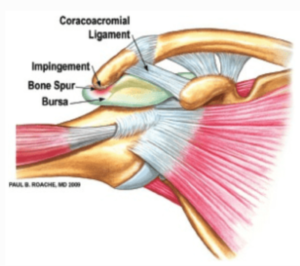- Anatomy
- Conditions
- Procedures
Summary of the Shoulder Joint
The shoulder is a ball-and-socket joint but with a special socket.
Three things make the shoulder socket special:
- The socket is mostly made of the rotator cuff. Most of the soft tissues of the socket are the muscle and tendon of the rotator cuff. The rest are the ligaments and joint lining of the socket, called the capsule.
- The socket has a hard roof. The bone and ligament of the arch over the rotator cuff provide support for the tendons as they slide in the socket. There is an important pad to cushion the tendons from the hard roof called a bursa.
- The socket is mobile. The scapula (shoulder blade) is the bony foundation of the socket. The scapula and the socket it supports are mobile. This gives the shoulder a tremendous range of motion. This motion requires coordination and balance of the muscles around the shoulder, particularly the rotator cuff.
Deeper Understanding of the Anatomy of the Shoulder Joint
Basics: The Bones
Three bones make up the shoulder
- Clavicle (the collarbone)
- Scapula (the shoulder blade-shoulder socket lives here)
- Humerus (the ball of the socket)
Basics: The Joints
A joint is defined as the meeting point of two bones.
The three bones in the shoulder create three joints and one pseudo joint.
- The sternoclavicular joint (SC joint)
The SC joint connects the clavicle (collarbone) to the sternum (breast bone).
- The acromioclavicular joint (AC joint)
The AC joint connects the clavicle (collarbone) to the scapula (shoulder blade) at a superior portion of the scapula called the acromion.
- The glenohumeral joint (GH joint)
The GH joint connects the humerus (ball) to the scapula at the lateral portion called the glenoid (socket). This is the main joint of the shoulder and the ball and socket discussed above.
Basics: Shoulder Function
The main role of the shoulder is to position the hand. If you cannot position your hand correctly, your daily activity will be limited.
For example, difficulties with combing your hair, brushing your teeth, eating, getting dressed, working with your hands overhead, throwing a ball can all be difficult when your shoulder is injured.
Basics: The Shoulder Socket & Rotator Cuff
The shoulder socket is mostly made of the “rotator cuff”, which are four muscles and their tendons.
Four muscles and their tendons make up the rotator cuff. The tendons of the rotator cuff muscles are woven together and truly create a “cuff of tendon” around the proximal humerus (the ball) by their attachments to this ball, on the greater and lesser tuberosities. This is much like the cuff of a shirtsleeve.

This cuff of tendons is essential for rotation of the ball. This is why they are called the “rotator” cuff. These rotator cuff tendons are the key part of the socket.
These tendons surround the ball on three sides. Essentially, it is a three-sided box with one muscle on the front, one on the top, and two on the back. There are no rotator cuff muscles on the floor.
The key muscles of the shoulder used to elevate (lift) the arm are the rotator cuff muscles. There are four rotator cuff muscles. Each muscle is attached to a bone by two tendons, one at each end of the muscle.
The rotator cuff muscles function as a unit. As a unit, the rotator cuff has only one main function: keep the ball (the head of the humerus) centered in the socket. This is very important to give the arm a pivot point for elevating and/or rotating the arm. If you think of the ball and socket as similar to a golf ball on a tee, but surrounded by the rotator cuff, you will understand the basic function of the rotator cuff. No matter how the ball rotates, the muscles pull and keep tension on the ball, and keep it centered in the socket (in the center of the golf tee).
